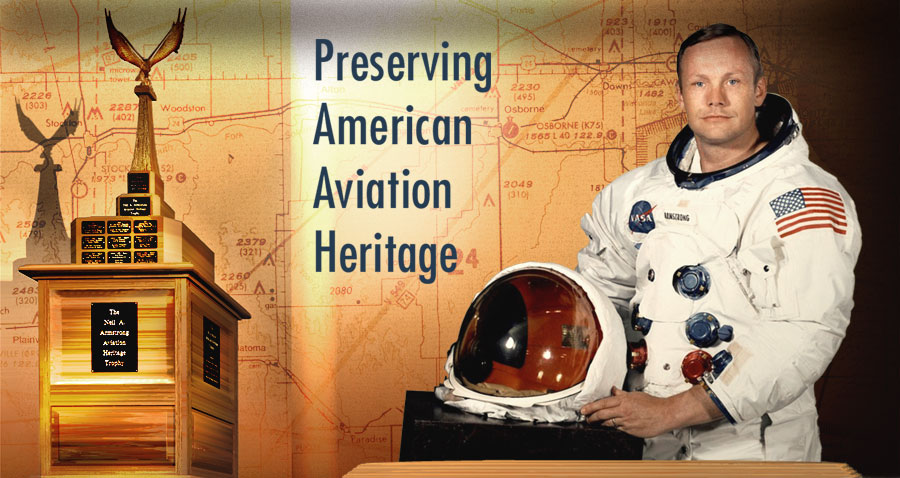


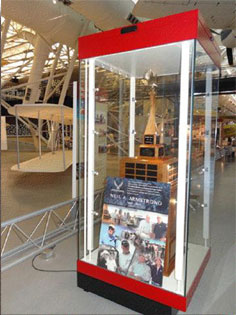 The National Aviation Heritage Invitational was established by Rolls-Royce North America in 1998.
The objective of the National Aviation Heritage Invitational is to encourage the preservation
of aviation history through the restoration of vintage aircraft to original flying condition.
The National Aviation Heritage Invitational was established by Rolls-Royce North America in 1998.
The objective of the National Aviation Heritage Invitational is to encourage the preservation
of aviation history through the restoration of vintage aircraft to original flying condition.
The Neil A. Armstrong Aviation Heritage Trophy resides full time in the new Steven F. Udvar Hazy Center of the Smithsonian National Air and Space Museum in Washington DC. The names of current and previous winners are engraved on plaques upon the trophy body.
The "Neil A. Armstrong Aviation Heritage Trophy" is awarded to the best of all classes entered for that event. This trophy is perpetual and shall remain on display at the Steven F. Udvar Hazy Center of the Smithsonian National Air and Space Museum in Washington DC with the participants and restorers name or facility on a brass plate installed on the trophy.

The National Aviation Heritage Invitational (NAHI) was privileged to have Neil Armstrong join us on many occasions to help present trophies to the winners of our annual vintage aircraft competition. Neil was an Enshrinee of the National Aviation Hall of Fame and represented the organization at the annual NAHI competitions both in Reno, NV and Dayton, OH. He actively supported NAHI and personally presented the winning trophies during the presentation ceremonies at both events.
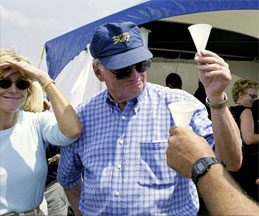 Neil acknowledged that he discovered his love and passion for flying back in the 1930's
during the "Golden Age of Flight". He was thrilled to walk among the many Antique, Classic and
Military aircraft on the ramp each year. He would approach many of the owners to learn more
about the details of their particular aircraft or to take a peek into the cockpit.
He could not hide his smile when he would walk up to an aircraft and say that he
"dreamed of flying one of these" when he was a young boy.
Neil acknowledged that he discovered his love and passion for flying back in the 1930's
during the "Golden Age of Flight". He was thrilled to walk among the many Antique, Classic and
Military aircraft on the ramp each year. He would approach many of the owners to learn more
about the details of their particular aircraft or to take a peek into the cockpit.
He could not hide his smile when he would walk up to an aircraft and say that he
"dreamed of flying one of these" when he was a young boy.
At our annual NAHI events, Neil Armstrong was not an Astronaut or a world figure, but was another aviation enthusiast who loved seeing our rich aviation history being kept alive for future generations to enjoy. NAHI truly brought joy and happiness to Neil Armstrong.
When Neil passed away in 2012, the leaders of the four founding organizations; Rolls-Royce, the Smithsonian National Air and Space Museum, the National Aviation Hall of Fame and the Reno Air Racing Foundation agreed unanimously to rename the Rolls-Royce Aviation Heritage Trophy after Neil A. Armstrong. The trophy was unveiled by his fellow Hall of Fame Enshrinees and presented for the first time in September, 2012.
NAHI is very proud and honored to have been a part of Neil Armstrong's life and to carry on his name and passion for aviation for future generations.
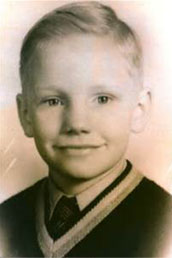 Armstrong's second and last mission into space was as Mission Commander of the Apollo 11
moon landing in July of 1969. On this famous "One giant leap for mankind" mission,
Armstrong and Buzz Aldrin descended to the lunar surface and spent 2.5 hours exploring the
moon while fellow astronaut Michael Collins orbited above.
Armstrong's second and last mission into space was as Mission Commander of the Apollo 11
moon landing in July of 1969. On this famous "One giant leap for mankind" mission,
Armstrong and Buzz Aldrin descended to the lunar surface and spent 2.5 hours exploring the
moon while fellow astronaut Michael Collins orbited above.
In 1947, Armstrong began studying Aeronautical Engineering at Purdue University and received his Bachelor of Science degree in 1955. Before becoming an astronaut, he was an aviator for the United States Navy and saw action in the Korean War. Armstrong then went on to become a test pilot at the NACA High-Speed Flight Station, now known as the Dryden Flight Research Center, where he flew over 900 flights in a wide variety of aircraft. Later, Armstrong attended the University of Southern California, where he earned a Master of Science degree in Aerospace Engineering.
As a research pilot, Armstrong served as project pilot on the F-100 Super Sabre A and C aircraft, F-101 Voodoo and the Lockheed F-104A Starfighter. He also flew the Bell X-1B, Bell X-5, North American X-15, F-105 Thunderchief, F-106 Delta Dart, B-47 Stratojet and the KC-135 Stratotanker.
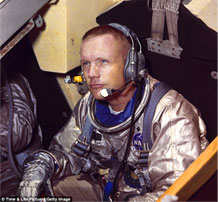 Armstrong announced shortly after the successful Apollo 11 flight that he planned not to
fly in space again. He was appointed as the Deputy Associate Administrator for aeronautics
for NASA's office of Advanced Research and Technology. He would serve in this role for 13 months,
retiring from the position and NASA in August of 1971. Later that year, he accepted a
teaching position as University Professor of Aerospace Engineering in the Department of
Aerospace Engineering at the University of Cincinnati. After teaching for eight years,
Armstrong retired in 1979.
Armstrong announced shortly after the successful Apollo 11 flight that he planned not to
fly in space again. He was appointed as the Deputy Associate Administrator for aeronautics
for NASA's office of Advanced Research and Technology. He would serve in this role for 13 months,
retiring from the position and NASA in August of 1971. Later that year, he accepted a
teaching position as University Professor of Aerospace Engineering in the Department of
Aerospace Engineering at the University of Cincinnati. After teaching for eight years,
Armstrong retired in 1979.
Armstrong was a Fellow of the Society of Experimental Test Pilots and the Royal Aeronautical Society; Honorary Fellow of the American Institute of Aeronautics and Astronautics, and the International Astronautics Federation. He was also a member of the National Academy of Engineering and the Academy of the Kingdom of Morocco. He served as a member of the National Commission on Space, as Vice-Chairman of the Presidential Commission on the Space Shuttle Challenger Accident and as the Chairman of the Presidential Advisory Committee for the Peace Corps.
Neil passed away in August of 2012 at the age of 82.